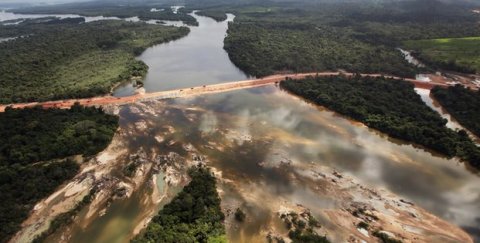Rainforest plays critical role in hydropower generation
Belo monte - The proposed Belo Monte dam will be one of the biggest in the world, but deforestation could limit the amount of energy generated
Deforestation in the Amazon region could significantly reduce the amount of electricity produced from hydropower, says a new study.
Scientists say the rainforest is critical in generating the streams and rivers that ultimately turn turbines.
If trees continue to be felled, the energy produced by one of the world's biggest dams could be cut by a third.
The study is published in the Proceedings of the National Academy of Sciences.
Many countries in tropical regions are turning to hydropower as an untapped source of energy. In Brazil around 45 new hydro plants are in the planning stage.
“We now have very strong evidence that Brazil's ability to generate electricity depends on forest conservation” Dr Daniel Nepstad
Rainforests, by their very name, are prime locations for the dams that are usually required to create the force of water needed to generate electric power.
Until now the presumption has been that cutting down the trees near a dam actually increased the amount of water flowing into the dams.
Trees of life
But in this new study the researchers took a broader look at the climate projections for the Amazon basin and not just at the rivers on which the dams were built.
They found that rainforests are more critical than previously thought as they produce the rain that fills the streams that ultimately drives the rivers and the turbines.
"Rainforests generate their own rainfall, " Dr Claudia Stickler, from the Amazon Environmental Research Institute International Programme (IPAM-IP), told BBC News.
Deforestation Brazil has had some success in curbing deforestation but there are worries that the rate will rise in the coming years
"They pull water out of the soil on a daily basis, they stay green and dark. The main reason is they are always pumping moisture into the atmosphere which ultimately ends up being rainfall and that's what keeps these streams going too," she said.
The scientists found that thanks to current levels of deforestation in the region, rainfall is 6-7 percent lower than it would be with full forest cover. Predictions for 2050 suggest a 40% loss of forest, meaning significantly less rain and 35-40 less electric power.
They researchers looked closely at Brazil's highly controversial Belo Monte dam, said to be the world's third largest hydropower project. If deforestation continues the scientists say, the project will deliver 30% less power than currently estimated. That's equivalent to the energy used by 4 million Brazilians.
"We now have very strong evidence that Brazil's ability to generate electricity depends on forest conservation," said co-author Dr Daniel Nepstad, executive director of IPAM-IP.
"These results aren't just important for Brazil - rainforest cover could affect energy production in wet tropical areas throughout the Amazon, and in Africa and South East Asia as well."
The researchers say their work shows that rainforests are not just important for biodiversity, for the storage of carbon but for the very tangible issue of energy production.
The authors praise the steps that Brazil has taken in recent years to curb deforestation, but they are concerned that the clearing of trees could now be on the rise once again.
"In the last year, Brazil has made tremendous progress towards ending deforestation, bringing clearing rates down to 24% of the historical average. But these numbers are starting to creep up again, and everyone should be concerned," said Dr Nepstad.
"Ending deforestation should be viewed as an issue of national energy security."





Recent comments